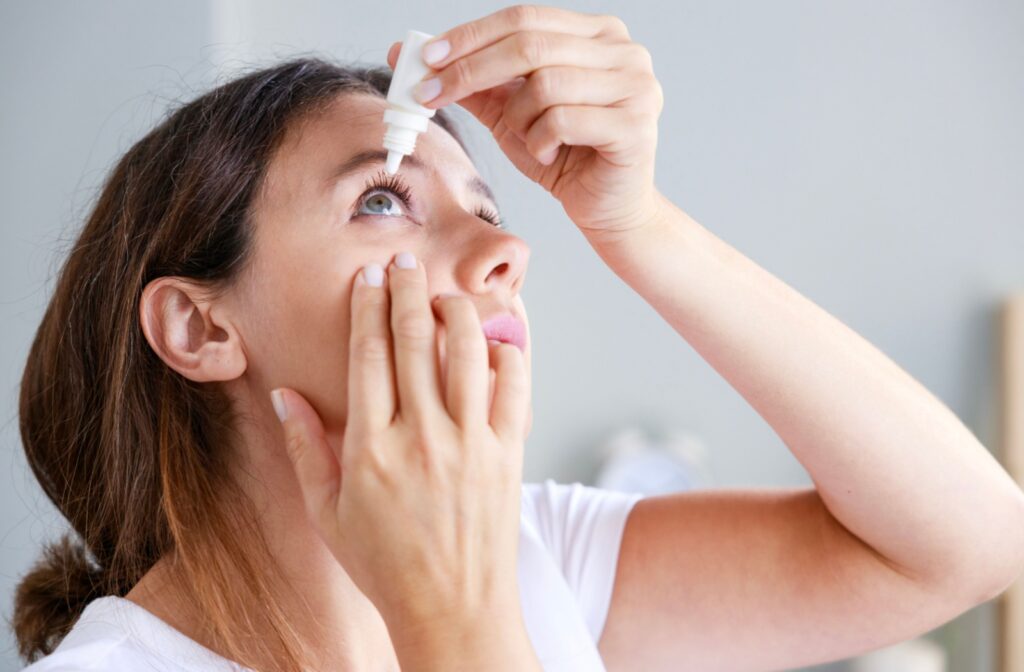Do you find yourself with dry eyes, reaching for eye drops and a headache, rubbing your temples more often than usual? While it may seem like dry eyes cause headaches, they are simply coincidental. However, it’s still important to consider the potential underlying cause of both. If there is a shared trigger, pinpointing it and changing your daily routine could reduce your symptoms.In this blog, we will delve into the dry eye side of these conditions and explore strategies for managing and treating symptoms effectively.
Understanding Dry Eye
Dry eye occurs when the eyes do not produce enough tears or are unable to due to improper chemical composition. Tears are an essential component to your eye health. They are a complex mixture of water, oils, and proteins like antibodies that play an important role in maintaining eye health and function.
Tears provide necessary moisture and lubrication to ensure your vision remains clear and your eyes stay comfortable. Tears also help wash away foreign particles and reduce the risk of eye infections by providing essential antimicrobial properties. Without a stable tear film, people may experience symptoms that significantly impact their daily lives.
Symptoms to Watch Out For
Some symptoms of dry eye disease include:
- Eye discomfort: burning, irritation, or a sensation of having something in your eyes.
- Visual disturbances: blurry vision or sensitivity to light.
Causes & Risk Factors
Continuous screen time can be a common culprit behind both dry eyes and headaches. Staring at screens for extended periods of time reduces the frequency of blinking, contributing to dryness. Simultaneously for some people, it also can lead to headaches. Taking breaks, using the 20-20-20 rule—look at something 20 feet away and take 20 full blinks every 20 minutes—and adjusting screen brightness can help alleviate the dry eye issues.
Another culprit for dry eyes and headaches could be caused by environmental factors. Low humidity, air movement, and exposure to smoke or air conditioning may contribute to dry eyes. Poor office lighting and even changes in atmospheric pressure may trigger headaches in sensitive people. Lastly, there are certain diseases, medications, and aging that can reduce tear production that may cause dry eyes or headaches. Check with your doctor if you are curious if your medications may be contributing the dry eye or headache symptoms.
Tips for Reducing Symptoms
- Stay hydrated.Proper hydration supports tear production, helping in preventing dry eyes. The body needs adequate fluids to produce tears— drink an appropriate amount of water daily.
- Blink regularly. Be conscious of blinking, especially during screen use, to keep your eyes moist. The reduced blink rate on screen can lead to dry eyes. So use the 20-20-20 rule described above to help keep your eyes fresh.
- Use artificial tears.Over-the-counter artificial tears can provide relief and maintain eye moisture. Consult with one of our optometrists to find out which drop type is best for you.
- Use a humidifier. Adding moisture to your indoor spaces can help combat dryness. Positioning a humidifier in areas where you spend the most time can help maintain adequate humidity levels for eye health.

Prevention & Management
While dry eyes don’t cause headaches, they share common origins like high screen time. By understanding this relationship and adopting preventive measures, you can take steps toward relieving discomfort, enhancing your overall eye health and possibly reducing headache frequency.
At In Focus Eyecare, we have advanced technology to diagnose and treat dry eyes beyond traditional care.
Traditional dry eye care includes:
- Artificial Tears—there are many kinds, and we’re here to help you select the right one for you!
- Warm Compresses—canimprove blood flow and relieve tension. The warmth promotes tear production, alleviates dryness, and relaxes the muscles around the eyes and forehead.
- Omega-3 Supplements—have anti-inflammatory properties that can help reduce your dry eye symptoms and inflammation.
Advanced dry eye care may include
- Tear and tear system analysis – this helps us understand what is wrong and how to best approach and manage your dry eyes. It also serves as a baseline to measure results against
- Prescription Medications— some medications can help increase tear production.
- Intensed Pulsed Light (IPL)—this treatment is designed specifically for controlling inflammation, a common issue in dry eye caused by meibomian gland dysfunction.
- Radiofrequency (RF) and iLux treatments—both of these treatments aid in remedying gland obstruction, which can cause dry eye.
To learn more about IPL, RF and iLux treatments for dry eye, check out our advanced dry eye treatments on our website!
Find the Source of Your Discomfort
Dry eyes do not cause headaches but they may occur coincidentally during strenuous tasks. An eye exam can help determine the source of your discomfort and with the proper care, it can help you enjoy comfortable vision again. If you’re experiencing dry eyes, headaches, or both, schedule an appointment with us at In Focus Eyecare, and we can help get to the bottom of your symptoms. For continued headaches, we also communicate with your family doctor or refer to specialists so we can get further expertise if needed.





